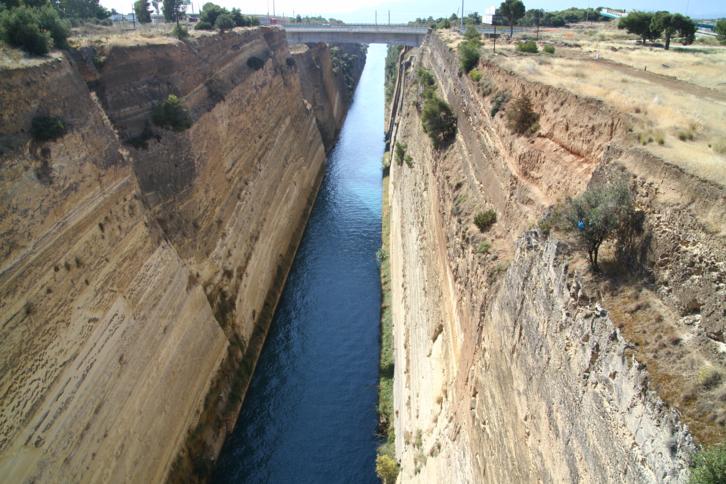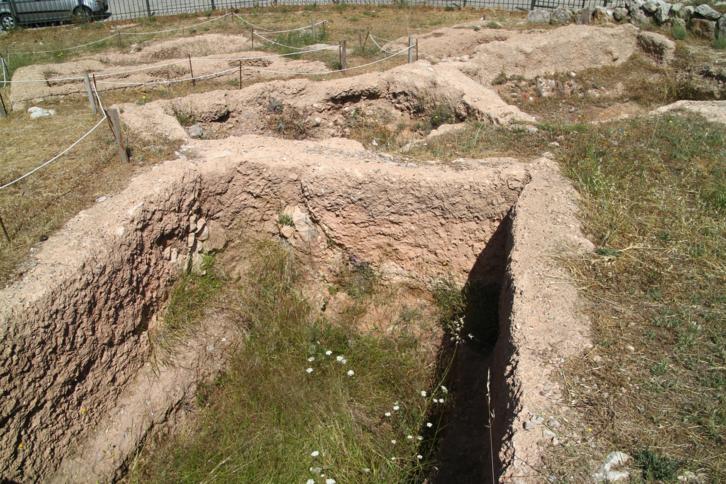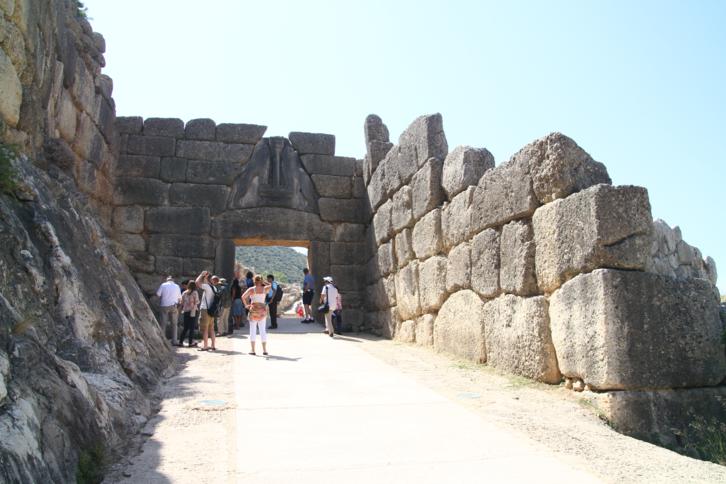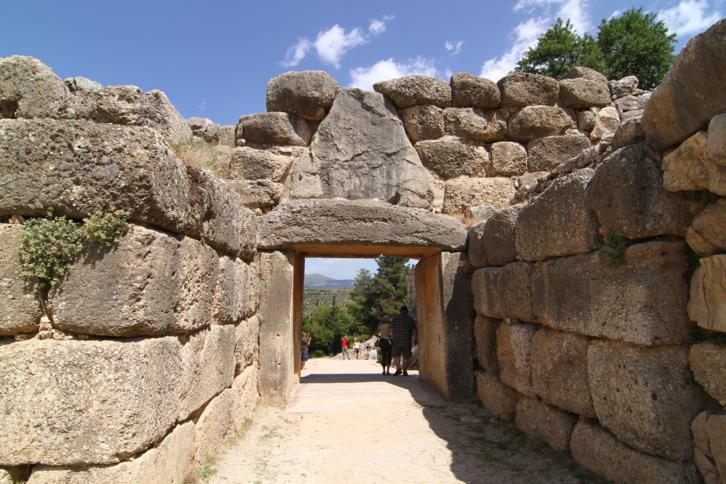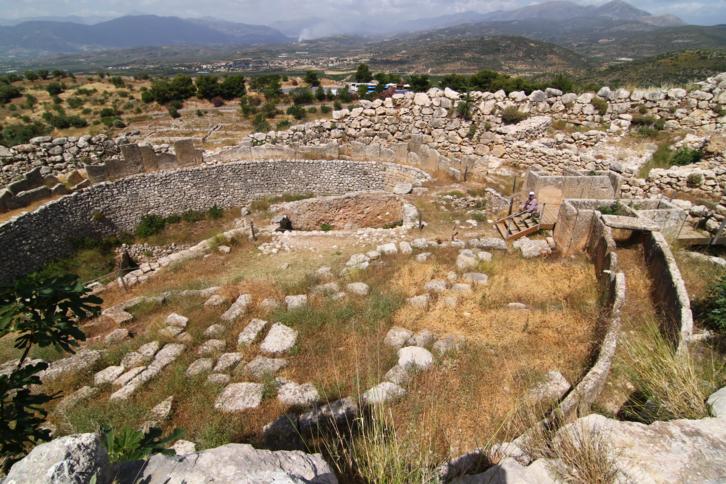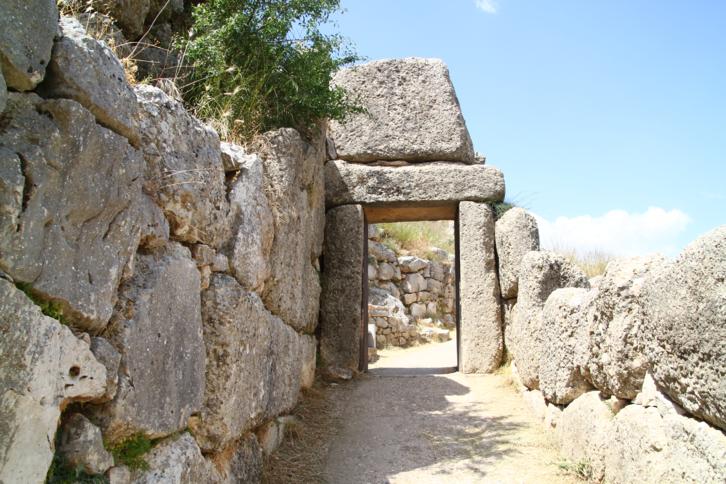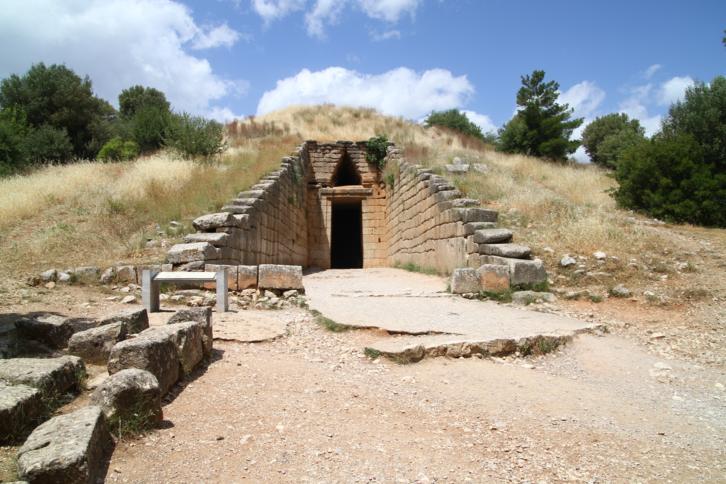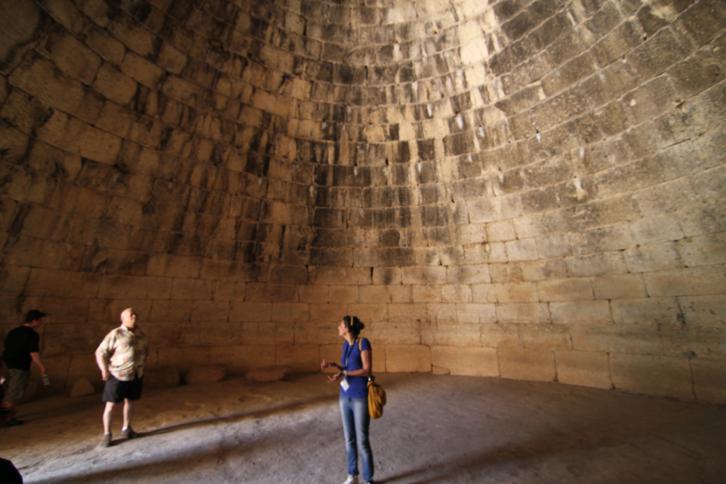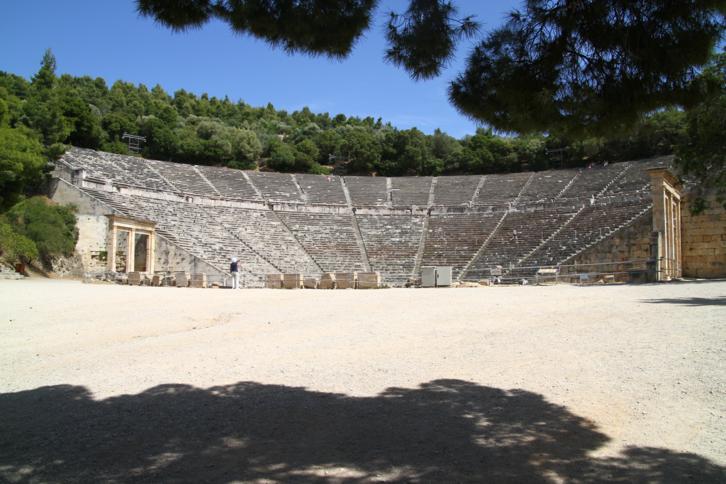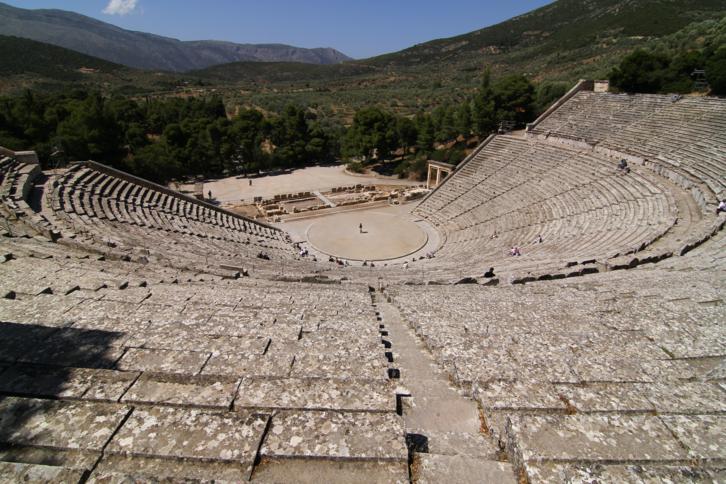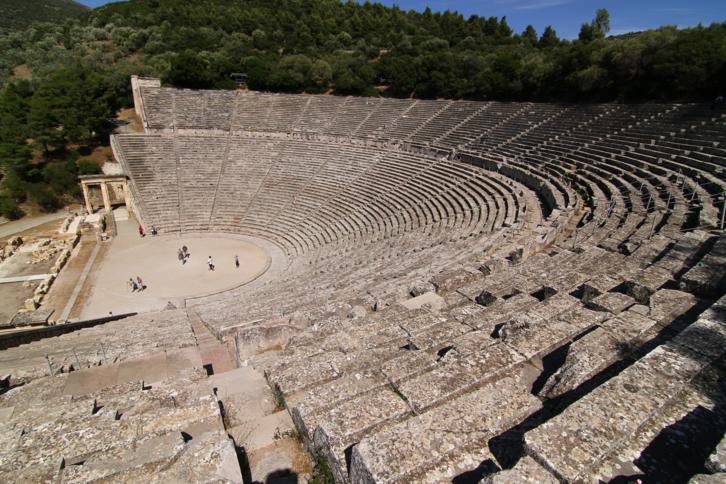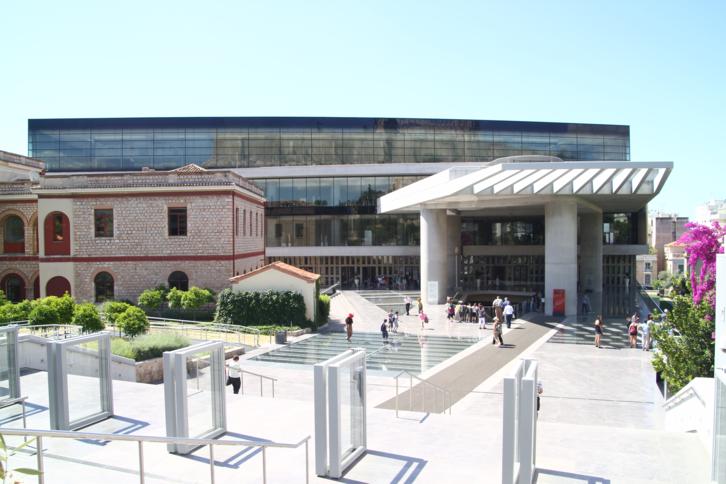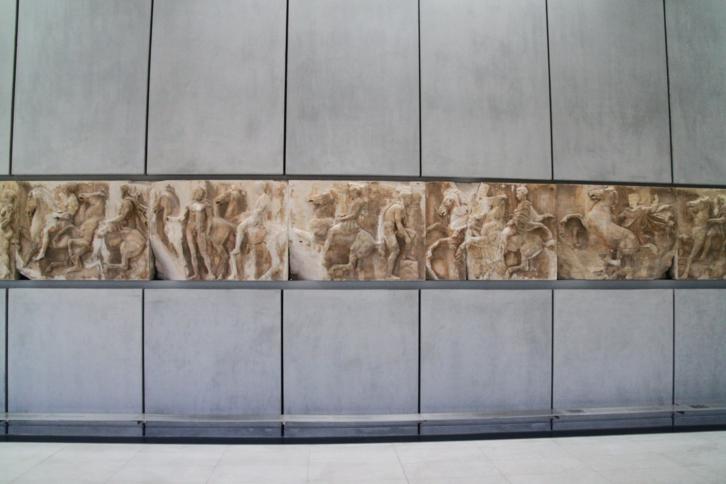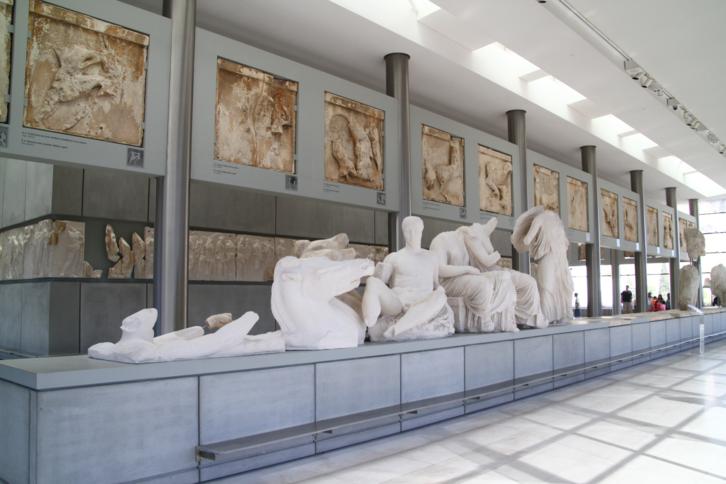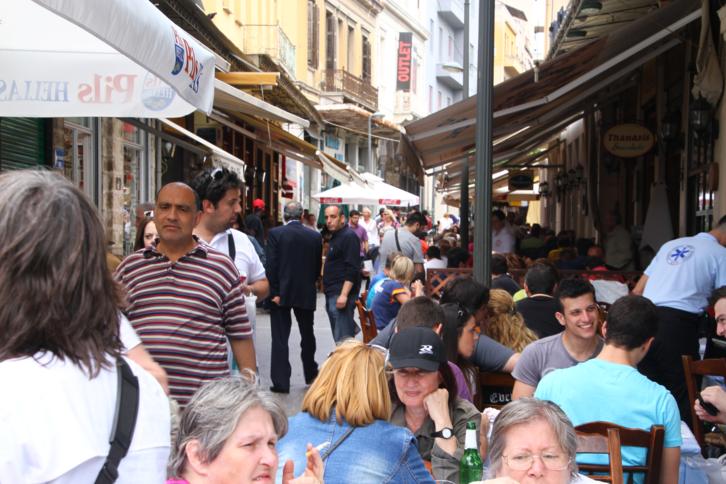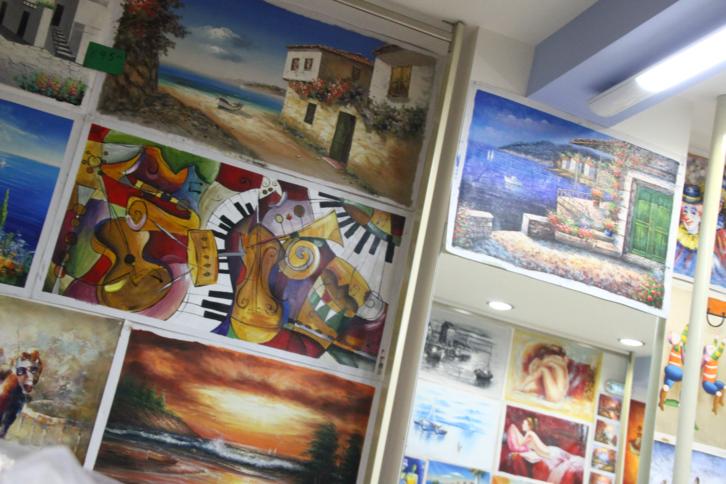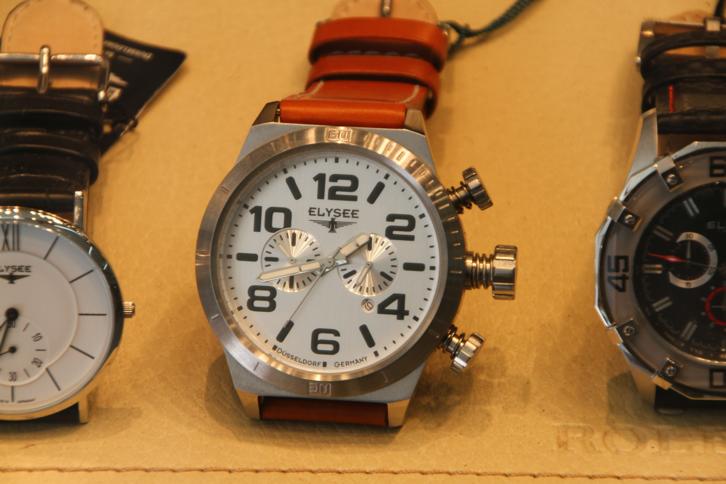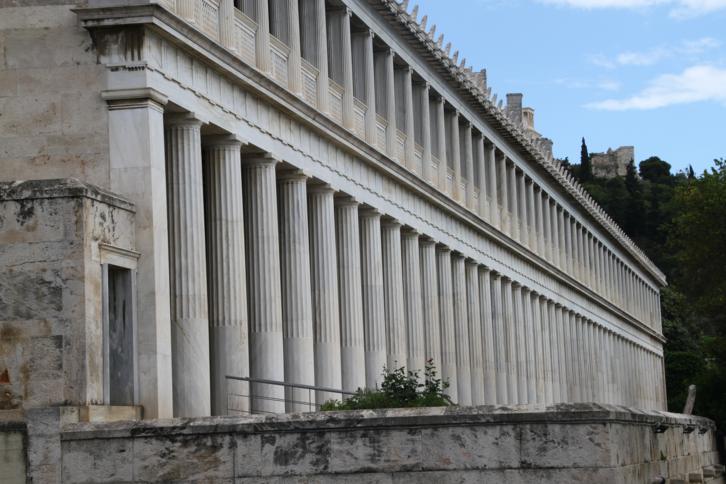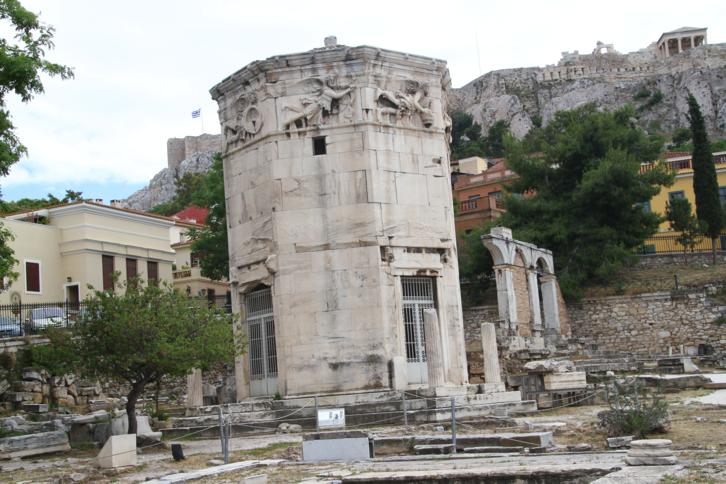|
Tuesday 22nd. May 2012
Today was the day we had selected to do the one day bus tour to Mycenae
and Epidaurus. It was a warmish day (about 27˚C)
and before we were out of Athens the air conditioning in the bus had
broken down. In normal circumstances this was really of no drama, but
our bus, being modern, didn't have windows that could be opened, in fact
upon watching the door close one realised that it was hermetically
sealed. The temperature inside the bus began to rise, the guide was told
by the driver that there was nothing wrong, that all was working well
and turned the fan speed higher, which didn't help cool anything. By the
time we reached Mycenae, the driver had to concede that there was a
problem and opened his window and the hatch in the roof to let some
fresh air in.
During this drama, we stopped for a photo stop at the Corinth Canal. The
guide's spiel was pretty well the same as I have included from a Google
search.
The Corinth Canal links
the Gulf of Corinth in the northwest with the Saronic Gulf in
the southeast. The canal is 3.9 miles (6.3 km) long and has a
water depth of 26 feet (8 m). Its width varies from a minimum of
69 feet (21 m) at the bottom to 82 feet (25 m) maximum at the
water's surface.
Before it was built, ships sailing between the Aegean and
Adriatic had to circumnavigate the Peloponnese adding about 185
nautical miles to their journey. The first to decide to dig the
Corinth Canal was Periander, the tyrant of Corinth (602 BCE).
Such a giant project was above the technical capabilities of
ancient times so Periander carried out another great project,
the diolkós, a stone road, on which the ships were
transferred on wheeled platforms from one sea to the other.
Dimitrios Poliorkitis, king of Macedon (c. 300 BCE), was
the second who tried, but his engineers insisted that if the
seas where connected, the more northerly Adriatic, mistakenly
thought to be higher, would flood the more southern Aegean. At
the time, it was also thought that Poseidon, god of the sea,
opposed joining the Aegean and the Adriatic. The same fear also
stopped Julius Caesar and emperors Hadrian and Caligula. The
most serious try was that of Emperor Nero (67 CE). He had 6,000
slaves for the job. He started the work himself, digging with a
golden hoe, while music was played. However, he was killed
before the work could be completed.
In the modern era, the first who thought seriously to carry out
the project was Capodistrias (c. 1830), first governor of
Greece after the liberation from the Ottoman Turks. But the
budget, estimated at 40 million French francs, was too much for
the Greek state. Finally, in 1869, the Parliament authorized the
Government to grant a private company (Austrian General Etiene
Tyrr) the privilege to construct the Canal of Corinth. Work
began on Mar 29, 1882, but Tyrr's capital of 30 million francs
proved to be insufficient. The work was restarted in 1890, by a
new Greek company (Andreas Syggros), with a capital of 5 million
francs. The job was finally completed and regular use of the
Canal started on Oct 28, 1893.
|
We finally arrived at Mycenae. The
whole site had been destroyed apart from one or two of the entrance
gates. Much of this may be of interest to an archeologist, but is fairly
meaningless to the average traveller.
After some hassles over lunch, where
those who had not ordered lunch as part of the tour had to wait around
at the Amalia Hotel, which was located in vineyards miles apparently
miles from anywhere, while those who had ordered lunch ate. When we
finally got into the bus again, we discovered we were only about a 5
minute drive to the town of Nafplion
with all its tavernas and bars. We were then given a 20 minute photo
break to get lunch and appreciate the views. The tour company nor guide
had offered to take us here while the others ate. (Stay clear of CHAT
Tours)
According to the myth,
Perseus's descendants reigned at Mycenae for three generations.
After the last of them, Eurystheas, died childless, the
Mycenaeans chose Atreus, son of Pelops, father of Agamemnon and
Menelaos, as their king.
Mycenae was founded between two tall conical hills, Profitis
Ilias (805 m.) and Sara (660 m.), on a low plateau dominating
the Argive plain and controlling both the land and sea routes.
The site was first occupied in the seventh millennium BC
(Neolithic period). Very little remains of this early settlement
because of continuous re-occupation up until the historical
period. Most of the monuments visible today were erected in the
Late Bronze Age, between 1350 and 1200 BC, when the site was at
its peak. In the early second millennium BC a small settlement
existed on the hill and a cemetery with simple burials on its
southwest slope. Grave Circle B, a stone-built funerary
enclosure containing monumental graves with rich grave gifts,
indicates that the first families of rulers and aristocrats
appeared at Mycenae at approximately 1700 BC. This social
structure developed further in the early Mycenaean period, c.
1600 BC, when a large central building, a second funerary
enclosure (Grave Circle A) and the first tholos tombs were
erected on the hill. The finds from these monuments show that
the powerful Mycenaean rulers participated in a complex network
of commercial exchange with other parts of the Mediterranean.
The construction of the palace and fortification wall currently
visible began c. 1350 BC (Late Helladic IIIA2). The latter saw
three construction phases, the first wall being built of
Cyclopean masonry. A new wall was erected to the west and south
of the early one approximately one hundred years later (Late
Helladic IIIB1), together with the Lion Gate, the citadel's
monumental entrance, and its bastion. Included in the newly
fortified area were the city's religious centre and Grave Circle
A, which was refurbished and used for ancestral cults. The
famous tholos tomb known as the 'Treasure of Atreus', with its
gigantic lintels and tall beehive vault, was probably built
during the same period. At approximately 1200 BC, in the Late
Helladic IIIB-C period, following a large destruction probably
caused by an earthquake, the walls were extended to the
northeast so as to include the subterranean well. Successive
destructions and fires led to the site's final abandonment c.
1100 BC.
After the collapse of the palatial system and of the 'Mycenaean
Koine', the hill was sparsely inhabited until the Classical
period. Meanwhile, several local cults of heroes developed in
the area, fuelled by Mycenae's fame, which the Homeric poems
spread throughout Greece. A temple dedicated to Hera or Athena
was erected on the top of the hill in the Archaic period. In 468
BC, after the Persian Wars, in which Mycenae took part, the town
was conquered by Argos and had part of its fortification wall
destroyed. In the Hellenistic period, the Argives founded a
'village' on the hill, repaired the prehistoric walls and the
Archaic temple, and erected a small theatre over the dromos of
the tholos tomb of Clytaemnestra. The town was abandoned in
subsequent centuries and was already in ruins when Pausanias
visited it in the second century AD.
In the eighteenth and nineteenth centuries, the impressive
Cyclopean walls of the Mycenaean acropolis attracted many
travellers and antiquaries who did not hesitate to loot the
site, taking advantage of the indifference and greed of the
Turkish authorities. In 1837, after the Greek Independence, the
archaeological site of Mycenae came under the jurisdiction of
the Greek Archaeological Society, whose representative K.
Pittakis cleared the Lion Gate in 1841. In 1876, after opening
several small test trenches in 1874, Heinrich Schliemann began
excavating Grave Circle A, where he uncovered five graves. His
work was continued in 1876-1877 by trench supervisor P.
Stamatakis who uncovered the sixth grave. In subsequent years C.
Tsountas (1884-1902), D. Evangelidis (1909), G. Rosenwaldt
(1911), A. Keramopoulos (1917) and A. J. B. Wace (1920-1923,
1939, 1950-1957) excavated the palace and cemeteries. In
1952-1955 I. Papadimitriou and G. Mylonas of the Greek
Archaeological Society excavated Grave Circle B and several
houses, while G. Mylonas with N. Verdelis of the Archaeological
Service excavated parts of the settlement. Excavations by the
British School at Athens under Lord W. Taylor uncovered the
religious centre, while further investigations were conducted by
the Greek Archaeological Society under G. Mylonas and S.
Iakovidis in 1959 and 1969-1974. In 1950-1955 A. Orlandos and E.
Stikas supervised the restoration of the Tomb of Clytaemnestra,
the palace, Grave Circle B and the area surrounding the Lion
Gate. The project for the 'Restoration-Conservation-Presentation
of the Monuments of the Acropolis of Mycenae and its Greater
Area', begun in 1998, was overseen initially by the Work Group
for the Restoration of the Monuments of Epidaurus and
subsequently by the Mycenae Committee, created in 1999.
Author:- Olga Psychogiou,
archaeologist |
Our final stop was Epidaurus, where
we looked over the amphithetre.
"The
Theatre of Epidaurus was built in the 4th century BC by
Polykleitos the Younger and thankfully for it remote
location much of it is still intact today, never having
the pilfering as other ancient sites have had over the
millennia. The theatre became over grown and buried,
believed to be just a hollow in the side of a hill until
it was discovered in the 19th century.
Theatre is 114m (374ft) across and has 35 rows of seats
divided into 34 blocks by stairs and walkways. The
bottom tier of 12 blocks was the original theatre built
in the 4th century BC, the top tier of 21 blocks was
built much later during the Roman period.
The
orchestra or stage is 20m (60ft) and the only one to
survive from antiquity. Supposedly if you drop a pin in
the centre of the orchestra you can hear it hit the
ground from any where in the theatre. The theatre is
still in use today with actors coming from all over the
world to perform there."
We got back to Athens at about
6:30pm, had some dinner a wandered around the Plaka looking at all the
cheap souvenirs etc for sale.
Wednesday 23rd. May 2012
Today was our last full day
in Greece. After an email and a phone call from CHAT Tours saying how
sorry they were for yesterday's misadventure and offering us a
complimentary half day tour if we wanted it. We refused, not wishing to
chance our luck with another bad bus trip. Instead we went to the new
Acropolis Museum. It seems that most of the antiquities remaining in
Greece are on display here. There are many hundreds of statues,
statuettes, pieces of pottery etc all dating back to 600 - 500 BC and
collected from all over Greece. One has to ask "What have the
Greeks have done since this halcyon era (Byzantine) apart from let the
country slowly fall into ruin?" They seem to have gone through a high
point about 2,500 years ago and everything has been on the decline ever
since. All the tourist attractions are ruins of buildings dating back to
this time! There seems to be little of any significance to show for the
last 25 centuries.
After lunch we went for another
wander through the Plaka area. Tomorrow we fly to Rome.
Thursday
24th. May 2012
We checked out of the Parthenon Hotel and made our way on foot to the
Museum underground station bought a €16
ticket to get us to the airport.
We eventually found the platform and train that would eventually get us
to Syntagma Station. There were plenty of signs to the Airport at Syntagma. We got on the first train heading towards the airport. This
happened to be a "suburban" train which meant we had to change trains
again at Dukassik. There was little indication that we would need to
change trains and we only managed via some hand signals with another
passenger. There was an express train from Syntagma but the novice had
no way to distinguish it from the suburban trains. If one was coming
from the Airport to Syntagma then only express trains leave from the
airport as the suburban network doesn't extend this far.
We arrived at the airport and checked in to our flight with Alitalia.
The flight took about 100 minutes to reach Rome and we arrived just
before 2:00pm local time. We waited at the
airport for about half an hour for the Terravision bus to come along and
take us into the centre of Rome. I had read on the internet that this
was a cheap way to get from the airport into the city. It only cost us
each €4, but as we reached the centre of Rome the bus just kept stopping in
the middle of the road for no apparent reason. There seemed to be no
apparent mechanical problem but the driver would turn the motor off,
wait, the start it again and drive 100 metres or so before stopping
again. All the cars behind us
were sounding their horns and then passing us. After about an hour and a
half on the bus we arrived at the Termini.
At the Termini, I was expecting to see ticket boxes etc, but at street level
they only have automatic machines that issue tickets to regional Italy,
but not the metro Lines. Someone explained that
we should buy our tickets from the tobacconist. So we lined up, and
eventually got two tickets for €1 each for the Metro Line. We followed the signs down into
the bowels of the Termini, passed the Metro Line ticket booths and
continued deeper and deeper. We found directions to the Blue Line and
the Red Line, but the arrows to the Red Line (which we wanted) suddenly
ceased. We finally found an information
booth hidden away in some dark corner and were directed down another
level. We eventually found the Red Line. The train trip covered about 6
stops. We got out but still needed guidance to
find the Hotel Prati. We finally arrived at the hotel at about 5:00pm,
somewhat hot and flustered.
At about 6:00pm we set off to Piazza Navona to join an evening
walking tour of Rome. This covered the Pantheon, Trevi Fountain, the
Monumento a Vittorio Emanuele ll (also known as the "Wedding Cake"
because it is white and ornate) and finally the Coloseum. The tour finished at about
9:15pm and we walked back to the hotel and had pizza and beer for dinner
along the way.
|



